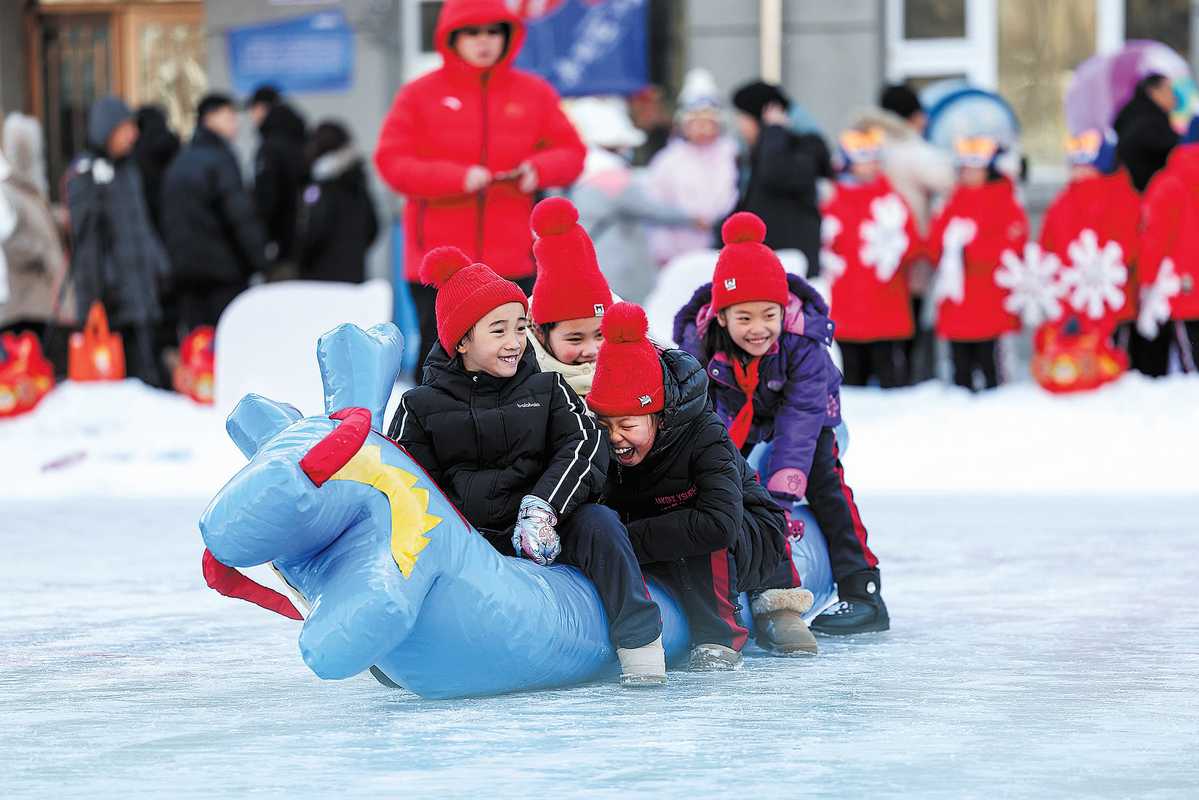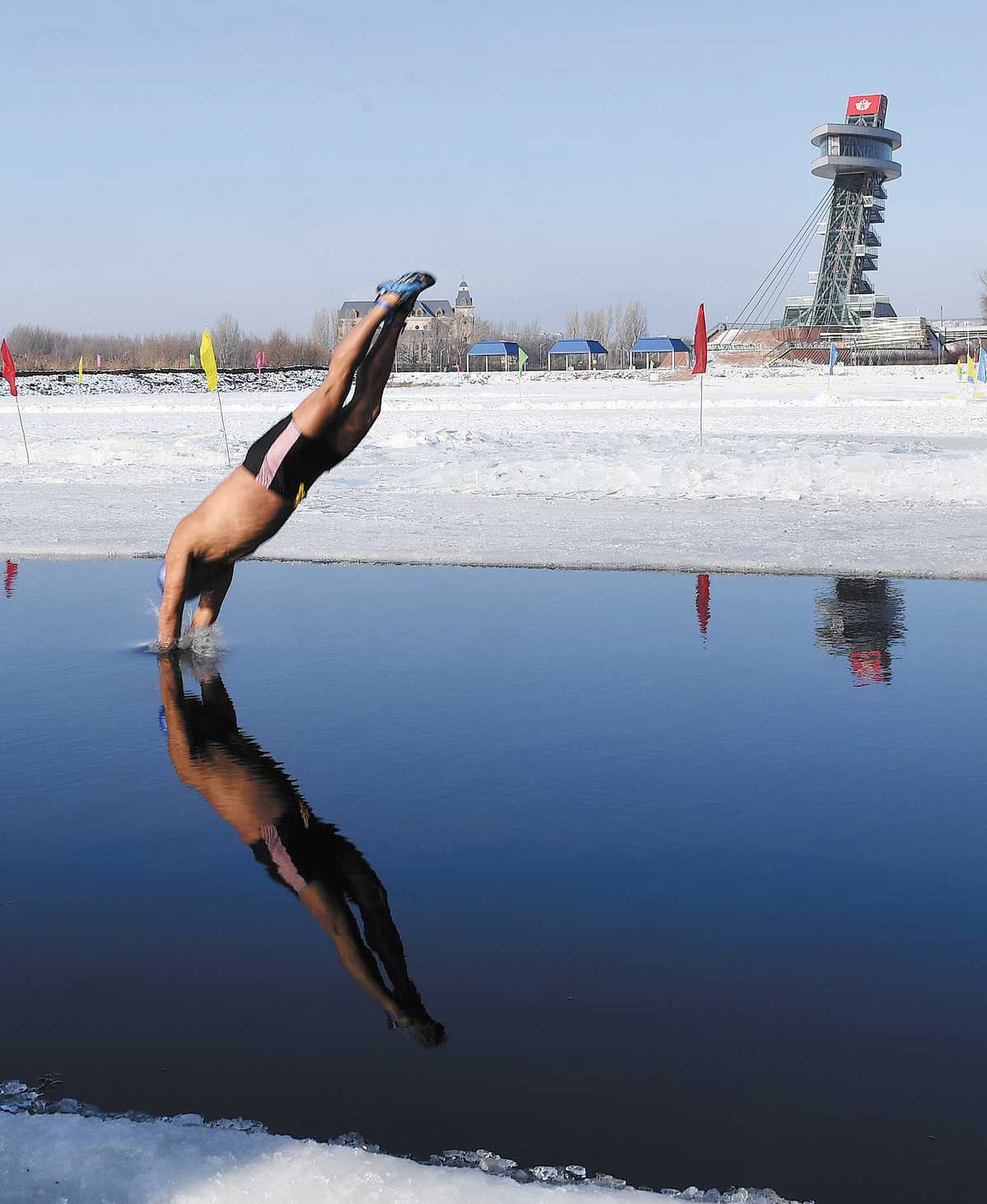
The ice sculpture of the CNS Liaoning aircraft carrier on the frozen Songhua River in Harbin, Heilongjiang province. PROVIDED TO CHINA DAILY
Despite the extremely cold weather, the frozen lake at the Qunli Lilac Park in Harbin, the capital city of Northeast China's Heilongjiang province is bustling with excitement.
Every autumn, staff members at the park fill the lake with water, and as the temperature drops, it turns into a natural ice rink.
Nearby residents flock to the park to skate and slide around, calling it their "winter wonderland", and the ongoing 9th Asian Winter Games in Harbin have further ignited local residents' passion for winter sports.
This winter, Harbin has fully utilized parks, squares, public institutions, universities and natural bodies of water to produce public ice rinks, ensuring that residents and visitors can participate in outdoor winter activities.
In Harbin, physical education classes in schools revolve around winter sports. Some schools have built ice rinks on their playgrounds, allowing children to enjoy the fun of ice and snow sports without having to leave the school grounds.

Pupils from Qingbin Primary School in Harbin enjoy playing on the ice. LIU YANG/FOR CHINA DAILY
"In the icy world of Harbin, children have a deep bond with ice skating and skiing from a young age," said skating coach Chen Ping. "Many students can glide on the ice and dash through the snow effortlessly, often without much guidance or training."
In conjunction with the Games, a series of youth activities are being held until March.
Over 400 ice rinks will be built in primary and secondary schools throughout the city, alongside nearly 150 cross-country skiing courses at schools with suitable conditions.
Moreover, classes in ice skating, skiing, ice hockey and curling have been organized, as well as other fun winter sports activities, like snow soccer matches.
Drawing inspiration
In early January, around 100 sculptors and workers spent more than 20 days constructing an ice sculpture of the CNS Liaoning aircraft carrier on the frozen Songhua River in Harbin.

At Harbin Engineering University, sketches of the CNS Fujian and the mascots of the 9th Asian Winter Games, Binbin and Nini, are drawn in the snow. PROVIDED TO CHINA DAILY
Built at a scale of 1 to 6, the sculpture used 350 metric tons of ice, and measured 72 meters long, 15 meters wide and stood 13 meters high.
"Different from traditional ice sculptures, it was built on a barge base with a steel frame, with its external shape crafted with ice blocks," said Chen Rongxin, designer of the sculpture.
During the construction process, the team modified its plans several times based on the ice's load-bearing capacity and the ship's weight to ensure the safety, accuracy and aesthetics of the sculpture.
At Harbin Engineering University, more than 1,600 teachers and students completed three massive snow drawings on campus, including one of China's third aircraft carrier, the CNS Fujian, and the mascots of the 9th Asian Winter Games, Binbin and Nini.
Students mapped out the drawings using high-precision positioning from the Beidou Navigation Satellite System.
Viewed from above, Binbin and Nini are depicted enjoying the snowy landscape as the latter soars into the air on a snowboard, as if saying hello to visitors from around the world.

Braving the extreme cold and strong winds, people swim in the freezing Songhua River. LIU YANG/FOR CHINA DAILY
"We spent about a month refining the outline, drawing it in using CAD (computer-aided design), and marking the key points," said Wang Qian, the overall director of the project and a teacher at the university's mechanical and electrical engineering school. "The design needed to be possible to recreate, and be aesthetically and artistically pleasing."
Despite the extreme cold, students were enthusiastic and proud of the completed work, which took around two hours to create.
Making a splash
In the past three decades, Yu Xiaofeng has never missed her daily swim in the Songhua River, even when temperatures in Harbin recently dropped to as low as — 20 C.
Yu, 61, a retired civil servant, is famous among winter swimmers in the city.
"I was born in Harbin and fell in love with swimming in my childhood, but until 1994, I never thought I could swim in the freezing Songhua River," she said. "In the late autumn of that year, I found some of my colleagues swimming in the river and decided to give it a try."
"It was not very cold at that time," she said. "However, when the weather became gradually colder, I found that I had adapted to the freezing water."

Braving the extreme cold and strong winds, people swim in the freezing Songhua River. LIU YANG/FOR CHINA DAILY
She became a longtime winter swimming enthusiast, and the extreme cold and strong wind on the river never dimmed her enthusiasm for a dip.
Before retirement, to avoid interfering with work, every day she would get up at about 5 am and go swimming after preparing breakfast for her son.
It became a habit that's lasted until today.
"It is not very easy to get up so early every day now, especially in the cold winter," she said. "The greatest victory is overcoming oneself."
Before diving into the icy river, she will do some warm-up exercises, such as jogging and yoga. And her jump into the Songhua River from a diving platform often draws a rousing ovation from the crowd.
"Winter swimming makes me feel healthy and I feel good," she said. "I will carry on doing it."
Contact the writers at zhouhuiying@chinadaily.com.cn